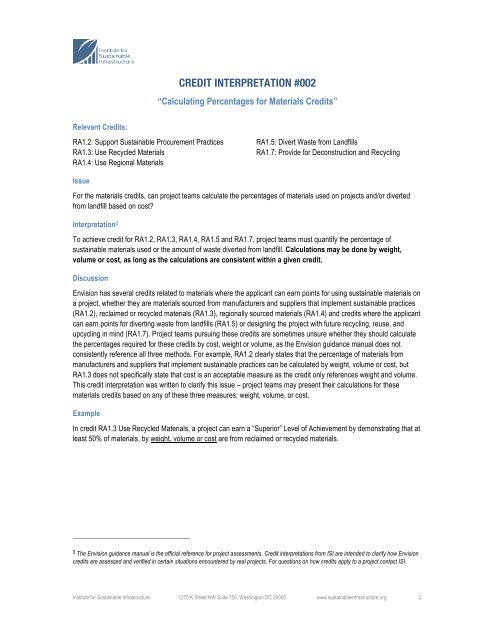Credit Interpretations
You also want an ePaper? Increase the reach of your titles
YUMPU automatically turns print PDFs into web optimized ePapers that Google loves.
CREDIT INTERPRETATION #002<br />
“Calculating Percentages for Materials <strong>Credit</strong>s”<br />
Relevant <strong>Credit</strong>s:<br />
RA1.2: Support Sustainable Procurement Practices<br />
RA1.3: Use Recycled Materials<br />
RA1.4: Use Regional Materials<br />
RA1.5: Divert Waste from Landfills<br />
RA1.7: Provide for Deconstruction and Recycling<br />
Issue<br />
For the materials credits, can project teams calculate the percentages of materials used on projects and/or diverted<br />
from landfill based on cost?<br />
Interpretation 3<br />
To achieve credit for RA1.2, RA1.3, RA1.4, RA1.5 and RA1.7, project teams must quantify the percentage of<br />
sustainable materials used or the amount of waste diverted from landfill. Calculations may be done by weight,<br />
volume or cost, as long as the calculations are consistent within a given credit.<br />
Discussion<br />
Envision has several credits related to materials where the applicant can earn points for using sustainable materials on<br />
a project, whether they are materials sourced from manufacturers and suppliers that implement sustainable practices<br />
(RA1.2), reclaimed or recycled materials (RA1.3), regionally sourced materials (RA1.4) and credits where the applicant<br />
can earn points for diverting waste from landfills (RA1.5) or designing the project with future recycling, reuse, and<br />
upcycling in mind (RA1.7). Project teams pursuing these credits are sometimes unsure whether they should calculate<br />
the percentages required for these credits by cost, weight or volume, as the Envision guidance manual does not<br />
consistently reference all three methods. For example, RA1.2 clearly states that the percentage of materials from<br />
manufacturers and suppliers that implement sustainable practices can be calculated by weight, volume or cost, but<br />
RA1.3 does not specifically state that cost is an acceptable measure as the credit only references weight and volume.<br />
This credit interpretation was written to clarify this issue – project teams may present their calculations for these<br />
materials credits based on any of these three measures: weight, volume, or cost.<br />
Example<br />
In credit RA1.3 Use Recycled Materials, a project can earn a “Superior” Level of Achievement by demonstrating that at<br />
least 50% of materials, by weight, volume or cost are from reclaimed or recycled materials.<br />
3 The Envision guidance manual is the official reference for project assessments. <strong>Credit</strong> interpretations from ISI are intended to clarify how Envision<br />
credits are assessed and verified in certain situations encountered by real projects. For questions on how credits apply to a project contact ISI.<br />
Institute for Sustainable Infrastructure 1275 K Street NW Suite 750, Washington DC 20005 www.sustainableinfrastructure.org 2



